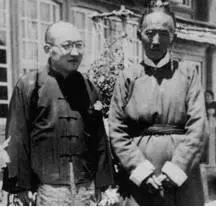It is almost certain that none of the official propagandists who demonize Tibet in Chinese publications had witnessed life in old Tibet. In fact, none of Beijing ’s Tibet propagandists in the West (Michael Parenti, Tom Grunfeld, Barry Sautman, Melvin Goldstein et al ) [74]had visited Tibet before 1980. The first two misrepresent old Tibet by selectively quoting English journalists and officials (L. A. Waddell, Percival Landon, Edmund Candler, Captain W.F.T. O’Connor) who accompanied the British invasion force of 1904, and who sought to justify that violent imperialist venture into Tibet by demonizing Tibetan society and government.

Dr. Shen with Tibetan Foreign Secretary, Surkhang Dzasa
The only high-ranking Chinese official with scholarly credentials who spent any length of time in old Tibet was Dr. Shen Tsung-lien, representative of the Republic of China in Lhasa (1944-1949). In his book Tibet and the Tibetans , Dr. Shen writes of a nation clearly distinct from China, and one that “…had enjoyed full independence since 1911.” He writes truthfully of a hierarchical, conservative society “fossilized many centuries back” but whose people were orderly, peaceable and hospitable – but also “notorious litigants,” adding that “few peoples in the world are such eloquent pleaders.” Shen also mentions “Appeals may be addressed to any office to which the disputants belong, or even to the Dalai Lama or his regent.” [75]

***

[1] Tibet was a fully functioning and independent state before the Chinese invasion. It threatened none of its neighbors, fed its population unfailingly, year after year, with no help from the outside world, and owed nothing to any country or international institution. Although insular, theocratic and not a modern democracy, Tibet maintained law and order within its borders and conscientiously observed treaties and conventions entered into with other nations. It was one of the earliest countries to enact laws to protect wildlife and the environment – recurrently cited in the “Mountain Valley Edicts” issued since 1642 [1] , and possibly earlier. [2] Tibet abolished capital punishment in 1913 (noted by many foreign travelers [3] ) and was one of the first nations in the world to do so. There is no record of it persecuting minorities (e.g. Muslims [4] ) or massacring sections of its population from time to time as China (remember Tiananmen) still does. Although Tibet ’s frontiers with India, Nepal and Bhutan were completely unguarded and Tibetans were “great travelers” [5] , very few Tibetans fled their country as economic or political refugees. There was not a single Tibetan immigrant in the USA or Europe before the Communist invasion. Tibetan soldiers with national flags
In 1642, the Fifth Dalai Lama issued the Rilung Tsatsik (ri klung rtsa tshig) generally translated as the Mountain Valley Edict. Another source describes it as a Decree for the Protection of Animals and the Environment. Since then, this edict was re-issued annually till 1958. Following the New Year Festivities, copies of the edict were distributed nationwide, and were displayed and read out to the assembled public by district officials. In order that its message suitably awe and instruct the document itself was physically impressive: about 3 feet wide and 6 or 7 feet in length, richly decorated with auspicious symbols and artwork around the border, and with the seal of the Dalai Lama at the bottom. French, Rebecca Redwood. The Golden Yoke , p 208, 209 & 213.
[2] Tibet was a fully functioning and independent state before the Chinese invasion. It threatened none of its neighbors, fed its population unfailingly, year after year, with no help from the outside world, and owed nothing to any country or international institution. Although insular, theocratic and not a modern democracy, Tibet maintained law and order within its borders and conscientiously observed treaties and conventions entered into with other nations. It was one of the earliest countries to enact laws to protect wildlife and the environment – recurrently cited in the “Mountain Valley Edicts” issued since 1642 [1] , and possibly earlier. [2] Tibet abolished capital punishment in 1913 (noted by many foreign travelers [3] ) and was one of the first nations in the world to do so. There is no record of it persecuting minorities (e.g. Muslims [4] ) or massacring sections of its population from time to time as China (remember Tiananmen) still does. Although Tibet ’s frontiers with India, Nepal and Bhutan were completely unguarded and Tibetans were “great travelers” [5] , very few Tibetans fled their country as economic or political refugees. There was not a single Tibetan immigrant in the USA or Europe before the Communist invasion. Tibetan soldiers with national flags
According to the scholar, Tashi Tsering (director of the Amnye Machen Institute) there are references to “ Mountain Valley ” edicts being issued during the Rimpung dynasty and the Tsangpa kings.
[3] Tibet abolished capital punishment in 1913 (noted by many foreign travelers [3] ) and was one of the first nations in the world to do so. There is no record of it persecuting minorities (e.g. Muslims [4] ) or massacring sections of its population from time to time as China (remember Tiananmen) still does. Although Tibet ’s frontiers with India, Nepal and Bhutan were completely unguarded and Tibetans were “great travelers” [5] , very few Tibetans fled their country as economic or political refugees. There was not a single Tibetan immigrant in the USA or Europe before the Communist invasion. Tibetan soldiers with national flags
Bell, Charles. Tibet Past and Present . London: Oxford University Press, 1924. See index: “Capital punishment abolished in Tibet, 142, 143, 236.”
Byron, Robert. First Russia then Tibet. London: Macmillan & Co., 1933. pg 204: “Capital punishment was now abolished.”
McGovern, William. To Lhasa in Disguise. New York: Century Co., 1924. pg 388-389.
Kingdon-Ward, Frank. In the Land of The Blue Poppies. New York: Modern Library, 2003. pg 22.
Winnington, Alan. Tibet : The Record of a Journey. London: Lawrence & Wishart Ltd., 1957. pg 99.
Brauen, Martin. Peter Aufschnaiter’s Eight Years in Tibet . Bangkok: Orchid Press, 2002. Pg 77: “There was no death penalty…”
[4] Tibet abolished capital punishment in 1913 (noted by many foreign travelers [3] ) and was one of the first nations in the world to do so. There is no record of it persecuting minorities (e.g. Muslims [4] ) or massacring sections of its population from time to time as China (remember Tiananmen) still does. Although Tibet ’s frontiers with India, Nepal and Bhutan were completely unguarded and Tibetans were “great travelers” [5] , very few Tibetans fled their country as economic or political refugees. There was not a single Tibetan immigrant in the USA or Europe before the Communist invasion. Tibetan soldiers with national flags
The few books available on Muslims in Tibet clearly reveal the tolerance of Tibetan government, church and society for this minority group:
Henry, Gray. Islam in Tibet . Louisville, Kentucky: Fons Vitae, 1997.
Читать дальше





![Edzard Ernst - Trick or Treatment. The Undeniable Facts about Alternative Medicine [Electronic book text]](/books/151762/edzard-ernst-trick-or-treatment-the-undeniable-fa-thumb.webp)








